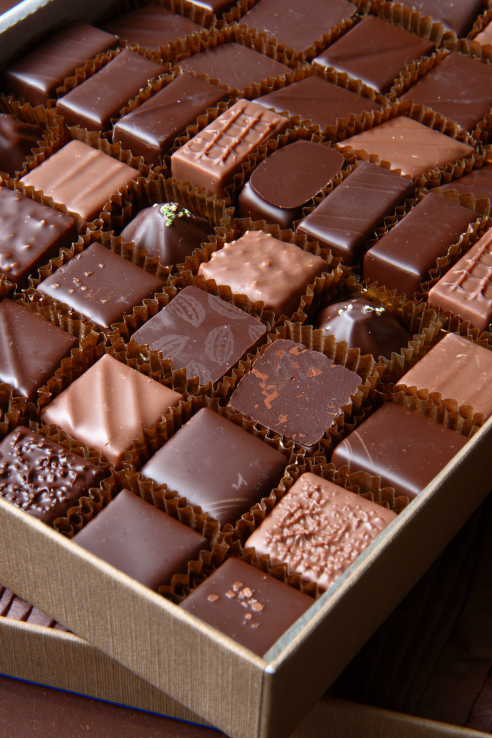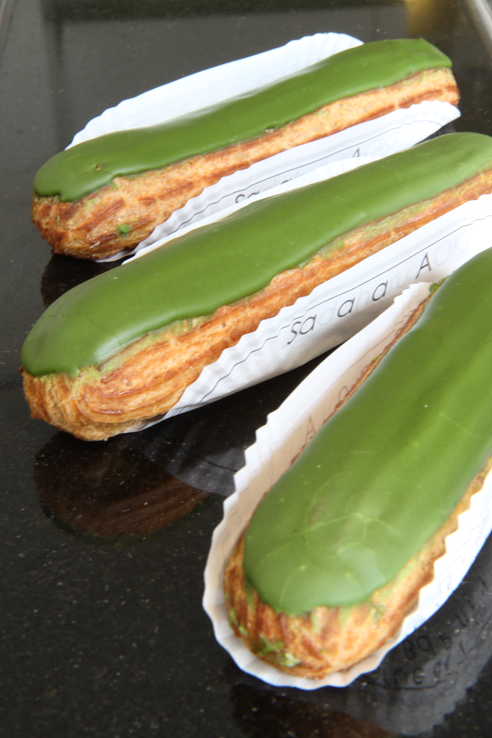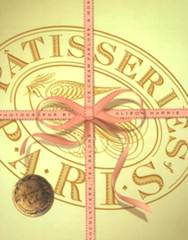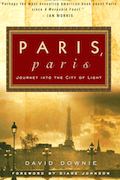Parisian Pastry Art, Part 2: Paris Present

- SUBSCRIBE
- ALREADY SUBSCRIBED?
BECOME A BONJOUR PARIS MEMBER
Gain full access to our collection of over 5,000 articles and bring the City of Light into your life. Just 60 USD per year.
Find out why you should become a member here.
Sign in
Fill in your credentials below.
 (Did you see Part I of this story? Click here to read it first.)
(Did you see Part I of this story? Click here to read it first.)
The minimalism of contemporary pastry art can be spectacular. A Paris-trained American pastry chef friend of mine from New York came to dinner carrying a hatbox. She lifted the lid and everyone gasped. “It’s a pastry radiator,” I couldn’t help exclaiming. The “radiator’s” buttery pastry fins were filled with ethereal cream, shielded by dark chocolate plates and mounted on a hard nougatine U-shaped base reminiscent of Bakelite.
“Actually it’s a vertical millefeuille,” my friend explained as she heated the blade of a long knife—the only way to slice this incredible, gorgeous delicacy without destroying it.
The “radiator” turned out to be the conceptual-art brainchild of culinary designer Marc Brétillot, whose creations have often been spotted in the pastry department at the Bon Marché’s Grande Épicerie.
“Pastry is art,” Philippe Muzé, for a decade the wonder-worker at Paris’s bastion of traditionalism, Dalloyau, told me (he has since moved on and on and won many awards).
“It’s poetry,” he added. “You can turn sugar, chocolate, herbs, spices and fruit into a million flavors and colors.”
I hesitated before deconstructing his green Gâteau Vert, discovering a raspberry-colored biscuit, pear mousse, hot Szechwan pepper, cardamom, thyme and paprika.
“First comes the concept, then the testing—but the result has got to taste good,” Muzé hastened to explain. Even more spectacular was his Le Gâteau—a hollow chocolate cube that when lifted revealed delicate layers of crisp biscuit and raspberry compote with balsamic vinegar, pistachio, milk chocolate ganache and black chocolate mousse.
Muzé, while working as Patina’s executive pastry chef, whipped up something equally wild for the the Governor’s Ball: the Dark Chocolate Decadence. Dubbed the “wow” dessert of this signal social event—it follows the Emmy Awards—Muzé’s dessert is built atop a brownie base salted with smoked fleur de sel, itself topped with a superstructure of chocolate ganache and chocolate mousse, coated with chocolate glaze, the whole thing then decorated with whipped “chocolate chantilly” and crowned by a wantonly brittle flake fashioned from cocoa nib nougatine.
Back to Paris, where East meets West in the person of young but ambitious Sadaharu Aoki. Sadu came to Paris from Japan in the early 1990s, learned the pastry-maker’s art from Pierre Hermé, and then in 2001 opened his first Paris pastry boutique—and I emphasize the word “boutique.” Jewel-like in conception, execution and display, Aoki’s revisited French classics merge ingredients and inspiration from the tea ceremony. There are green tea millefeuilles and madeleines, for instance, plus green tea éclairs and others with black sesame seeds.
 Scattered across town are equally stunning offerings in the windows of celebrity pastry or chocolate maestros Guy Mulot, Christian Constant, Peltier, Kaiser, Lenôtre, Fauchon, Hédiard, Sucré Cacao, Laurent Duchêne, Lahrer, Patrick Roger, and a dozen others.
Scattered across town are equally stunning offerings in the windows of celebrity pastry or chocolate maestros Guy Mulot, Christian Constant, Peltier, Kaiser, Lenôtre, Fauchon, Hédiard, Sucré Cacao, Laurent Duchêne, Lahrer, Patrick Roger, and a dozen others.
When it comes to visual and gustatory artistry, however, not to mention marketing and promotional skills, Pierre Hermé’s talent is hard to top. Step under the spotlights of his chic bijou boutique on rue Bonaparte to learn the meaning of dazzle. The alliteration in “Picasso of Pastry” is clever, but Hermé hasn’t invented the equivalent of Cubist pâtisseries—yet. Perhaps Vogue meant Paloma Picasso. The master’s exquisite seasonal “collections” and “signatures” evoke not only artworks but also haute couture and jewelry, from “Ispahan” (a rose-flavored macaroon filled with rose-petal pastry cream, lychees and raspberries) to the astonishing “Surprise” (a plump meringue shell over an almond base, with strawberry and exotic fruit marmalade trapped between).
Perhaps after all Hermé, the epigone of Paris pastry and chocolate gurus, is a cross of modern minimalist and Renaissance master, meaning he’s flanked by a “school” of skilled artisans. In any case he certainly considers himself an artist and “architect of taste” endowed with an innate artistic sensitivity. It distinguishes the creative inventor from the dexterous if humble technician.
Likewise his views on dessert are haute and occasionally haughty: it’s not merely a meal’s sweet conclusion but its “apotheosis”. So once you’ve done the daunting Louvre and d’Orsay, treat yourself to some of Paris’s awesome, edible contemporary art—it’s a cakewalk.
(Did you see Part I of this story? Click here to read it first.)
Practical Information:
Sadaharu Aoki
56, boulevard de Port Royal, Paris 5th
Tel : 01 45 35 36 80
Métro: Port Royal, Gobelins
Shop hours: Tuesday-Saturday 10:00AM-7:00PM; Sunday 10:00AM-6:00PM; closed Monday
3 other Paris locations
Jean-Paul Hévin Shop and Chocolate Bar
231, rue Saint-Honoré, Paris 1st
Tel : 01 55 35 35 96
Métro : Concorde, Tuileries, Opéra
Shop hours: Monday-Saturday 10:00AM-7:30PM; closed Sunday
Chocolate Bar hours: Monday-Saturday 12:00PM-7:00PM; closed Sunday
3 other Paris locations
David Downie moved to Paris from San Francisco to Paris in the 1980s. His travel, food and arts features have appeared in magazines and newspapers worldwide. He’s the author of over a dozen books, including Paris, Paris: Journey into the City of Light and Quiet Corners of Rome . Please see davidddownie for more about David.
Photography credits: Images copyright ©Alison Harris, photographer of Pâtisseries of Paris.
Do you have news to share with our readers? Please send us your stories & ideas.
NEW: Subscribe for free to our weekly newsletters with subscriber-only stories.
Update your travel books, DVDs & French imports: our current recommendations.
Thank you for using our link to Amazon.com…your purchases support our free site.
Top 100 Readers’ Favorite Amazon.com Items. (Please wait for Amazon.com widget to load)
Click on image for more info about these favorites.
More in Cafe, Crime in Paris, cultural differences, Dining in Paris, Eating in Paris, France, France courtship, France gay marriage, French civil unions, French cocktails, French etiquette, French recipes, French sex, French tourism, French wine, gay sex in France, Holidays in France, Hotels, Jewish Paris, Jews in Paris, marriage in France, Monument, Museum, Neighborhood, Nightlife, Paris, Paris bistros, Paris bistrot, Paris cafes, Paris history, Paris restaurants, Paris sightseeing, Paris tourism, Paris tourist tips, same sex marriage, sex in France, Shopping, sightseeing, Street drugs Paris





